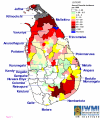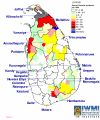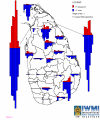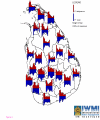Sri Lanka malaria maps
- PMID: 12914667
- PMCID: PMC183859
- DOI: 10.1186/1475-2875-2-22
Sri Lanka malaria maps
Abstract
Background: Despite a relatively good national case reporting system in Sri Lanka, detailed maps of malaria distribution have not been publicly available.
Methods: In this study, monthly records over the period 1995 - 2000 of microscopically confirmed malaria parasite positive blood film readings, at sub-district spatial resolution, were used to produce maps of malaria distribution across the island. Also, annual malaria trends at district resolution were displayed for the period 1995 - 2002.
Results: The maps show that Plasmodium vivax malaria incidence has a marked variation in distribution over the island. The incidence of Plasmodium falciparum malaria follows a similar spatial pattern but is generally much lower than that of P. vivax. In the north, malaria shows one seasonal peak in the beginning of the year, whereas towards the south a second peak around June is more pronounced.
Conclusion: This paper provides the first publicly available maps of both P. vivax and P. falciparum malaria incidence distribution on the island of Sri Lanka at sub-district resolution, which may be useful to health professionals, travellers and travel medicine professionals in their assessment of malaria risk in Sri Lanka. As incidence of malaria changes over time, regular updates of these maps are necessary.
Figures





References
-
- Konradsen F, Amerasinghe FP, Van der Hoek W, Amerasinghe PH. Malaria in Sri Lanka: Current knowledge on transmission and control. Colombo: International Water Management Institute. 2000.
-
- Konradsen F, Van der Hoek W, Amerasinghe PH, Amerasinghe FP, Fonseka KT. Household responses to malaria and their costs: a study from rural Sri Lanka. Trans R Soc Trop Med Hyg. 1997;91:127–130. - PubMed
-
- Ramasamy R, Subanesan N, Wijesundere A, Fernando NK, Ramasamy MS. Observations on malaria patients seeking treatment in hospitals in a rural and an urban area of Sri Lanka. Indian J Malariol. 1992;29:29–34. - PubMed
Publication types
MeSH terms
LinkOut - more resources
Full Text Sources
Medical
Research Materials

